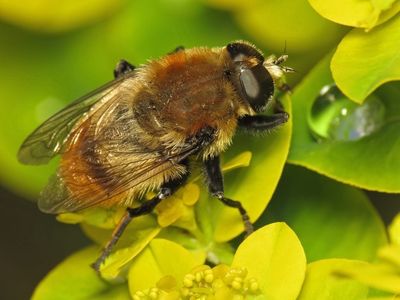What are Bulb Flies?
You may have seen bulb flies flitting about your garden and thought nothing of it. The narcissus bulb flies look a bit like tiny bumblebees and seem charmingly innocuous. The lesser bulb flies look like flies but still don’t seem very sinister. The true villains are the larvae of either species. Once eggs are laid and larvae hatch, they creep into soil and burrow into the base of the bulb. There they overwinter, feasting on the material that was supposed to develop into daffodils, hyacinth and other popular blooms. Bulb flies of either species do little harm in their “fly” state. The insects are not native to North America but were introduced from Europe in the late 1860s. They are now widespread in the region and affect plants such as:
Narcissus Hyacinth Iris Lily Tulip Daffodil Amaryllis
Lesser bulb flies can even infest parsnips and plants in the Allium family such as garlic. The best tip on how to kill bulb flies is to capture the adult insects before they can lay their eggs. Each female captured can reduce the population of larvae by 100 potential bulb destroyers. These larvae tunnel into the soil through the basal leaves of the plant until they reach the bulb. There they overwinter and munch their way through the layers of the bulb.
Controlling Bulb Flies
Bulb fly management relies upon prevention, as there are no natural enemies of the insect and most insecticides prove to be more toxic than beneficial. The use of insect nets or sticky traps is an effective and safe bulb fly control. Unfortunately, these measures can also trap beneficial insects such as bees. Removing bulbs after they have died back and separating those with damage from the healthy bulbs can reduce springtime populations of adults. Additionally, mowing the basal leaves back and cultivating around the basal area of the bulb will prevent holes that the pests bore into. The cultural methods of controlling bulb flies are usually sufficient to save the majority of the bulb population and reduce future pest problems. A hot bath is a treat for most of us but a hot water soak can be a death sentence for the destructive larvae. Submerge lifted bulbs in water that is 111 degrees Fahrenheit (44 C.) for 40 minutes. You can kill the adults by spraying pyrethrin based insecticides at the base of the plant. Contact with the spray can kill adults, however, pyrethroids cannot move through soil so this is only for topical contact for adults. Planting bulbs that are not host species or overplanting can reduce the damage from low infestations of the flies. Avoid planting bulbs with any damage where larvae have easy access to tunnel into the structure. In most cases, bulb flies are considered low impact pests where no chemical formulas are required.
